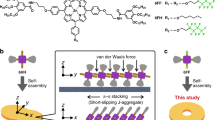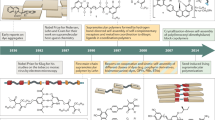Abstract
Self-assembly provides an attractive route to functional organic materials, with properties and hence performance depending sensitively on the organization of the molecular building blocks1,2,3,4,5. Molecular organization is a direct consequence of the pathways involved in the supramolecular assembly process, which is more amenable to detailed study when using one-dimensional systems. In the case of protein fibrils, formation and growth have been attributed to complex aggregation pathways6,7,8 that go beyond traditional concepts of homogeneous9,10,11 and secondary12,13,14 nucleation events. The self-assembly of synthetic supramolecular polymers has also been studied and even modulated15,16,17,18, but our quantitative understanding of the processes involved remains limited. Here we report time-resolved observations of the formation of supramolecular polymers from π-conjugated oligomers. Our kinetic experiments show the presence of a kinetically favoured metastable assembly that forms quickly but then transforms into the thermodynamically favoured form. Quantitative insight into the kinetic experiments was obtained from kinetic model calculations, which revealed two parallel and competing pathways leading to assemblies with opposite helicity. These insights prompt us to use a chiral tartaric acid as an auxiliary to change the thermodynamic preference of the assembly process19. We find that we can force aggregation completely down the kinetically favoured pathway so that, on removal of the auxiliary, we obtain only metastable assemblies.
This is a preview of subscription content, access via your institution
Access options
Subscribe to this journal
Receive 51 print issues and online access
$199.00 per year
only $3.90 per issue
Buy this article
- Purchase on Springer Link
- Instant access to full article PDF
Prices may be subject to local taxes which are calculated during checkout




Similar content being viewed by others
References
Yamamoto, Y. et al. Photoconductive coaxial nanotubes of molecularly connected electron donor and acceptor layers. Science 314, 1761–1764 (2006)
Percec, V. et al. Self-organization of supramolecular helical dendrimers into complex electronic materials. Nature 417, 384–387 (2002)
Würthner, F. et al. Supramolecular p–n-heterojunctions by co-self-organization of oligo(p-phenylene vinylene) and perylene bisimide dyes. J. Am. Chem. Soc. 126, 10611–10618 (2004)
Capito, R. M., Azevedo, H. S., Velichko, Y. S., Mata, A. & Stupp, S. I. Self-assembly of large and small molecules into hierarchically ordered sacs and membranes. Science 319, 1812–1816 (2008)
Dankers, P. Y. W., Harmsen, M. C., Brouwer, L. A., Van Luyn, M. J. A. & Meijer, E. W. A modular and supramolecular approach to bioactive scaffolds for tissue engineering. Nature Mater. 4, 568–574 (2005)
Powers, E. T. & Powers, D. L. Mechanisms of protein fibril formation: nucleated polymerization with competing off-pathway aggregation. Biophys. J. 94, 379–391 (2008)
Baskakov, I. V., Legname, G., Baldwin, M. A., Prusiner, S. B. & Cohen, F. E. Pathway complexity of prion protein assembly into amyloid. J. Biol. Chem. 277, 21140–21148 (2002)
Mulder, A. M. et al. Visualizing ribosome biogenesis: parallel assembly pathways for the 30S subunit. Science 330, 673–677 (2010)
Ferrone, F. A. Analysis of protein aggregation kinetics. Methods Enzymol. 309, 256–274 (1999)
Oosawa, F. & Kasai, M. A theory of linear and helical aggregations of macromolecules. J. Mol. Biol. 4, 10–21 (1962)
Powers, E. T. & Powers, D. L. The kinetics of nucleated polymerizations at high concentrations: amyloid fibril formation near and above the “supercritical concentration”. Biophys. J. 91, 122–132 (2006)
Bishop, M. F. & Ferrone, F. A. Kinetics of nucleation-controlled polymerization. Biophys. J. 46, 631–644 (1984)
Xue, W.-F. Homans, S. W. & Radford, S. E. Systematic analysis of nucleation-dependent polymerization reveals new insights into the mechanism of amyloid self-assembly. Proc. Natl Acad. Sci. USA 105, 8926–8931 (2008)
Knowles, T. P. J. et al. An analytical solution to the kinetics of breakable filament assembly. Science 326, 1533–1537 (2009)
De. Greef, T. F. A. et al. Supramolecular polymerization. Chem. Rev. 109, 5687–5754 (2009)
Cui, H. Chen, Z. Zhong, S., Wooley, K. L. & Pochan, D. J. Block copolymer assembly via kinetic control. Science 317, 647–650 (2007)
Lund, R. et al. Structural observation and kinetic pathway in the formation of polymeric micelles. Phys. Rev. Lett. 102, 188301 (2009)
Pasternack, R. F. et al. A nonconventional approach to supramolecular formation dynamics. the kinetics of assembly of DNA-bound porphyrins. J. Am. Chem. Soc. 120, 5873–5878 (1998)
George, S. J. et al. Helicity induction and amplification in an oligo(p-phenylenevinylene) assembly through hydrogen-bonded chiral acids. Angew. Chem. Int. Edn Engl. 46, 8206–8211 (2007)
Hoeben, F. J. M. Jonkheijm, P. Meijer, E. W. & Schenning, A. P. H. J. About supramolecular assemblies of π-conjugated systems. Chem. Rev. 105, 1491–1546 (2005)
Jonkheijm, P. Van der Schoot, P. Schenning, A. P. H. J. & Meijer, E. W. Probing the solvent-assisted nucleation pathway in chemical self-assembly. Science 313, 80–83 (2006)
Van Gestel, J. Amplification of chirality in helical supramolecular polymers: the majority-rules principle. Macromolecules 37, 3894–3898 (2004)
Pashuck, E. T. & Stupp, S. I. Direct observation of morphological transformation from twisted ribbons into helical ribbons. J. Am. Chem. Soc. 132, 8819–8821 (2010)
Lohr, A. & Würthner, F. Evolution of homochiral helical dye assemblies: involvement of autocatalysis in the “majority-rules” effect. Angew. Chem. Int. Edn Engl. 47, 1232–1236 (2008)
Wolffs, M. et al. The role of heterogeneous nucleation in the self-assembly of oligothiophenes. Chem. Commun. 4613–4615. (2008)
Ajayaghosh, A. Varghese, R. Praveen, V. K. & Mahesh, S. Evolution of nano- to microsized spherical assemblies of a short oligo(p-phenylene-ethynylene) into superstructured organogels. Angew. Chem. Int. Edn Engl. 45, 3261–3264 (2006)
Jonkheijm, P. et al. Transfer of π-conjugated columnar stacks from solution to surfaces. J. Am. Chem. Soc. 125, 15941–15949 (2003)
Xue, W.-F., Homans, S. W. & Radford, S. E. Systematic analysis of nucleation-dependent polymerization reveals new insights into the mechanism of amyloid self-assembly. Proc. Natl Acad. Sci. USA 105, 8926–8931 (2008)
Acknowledgements
We thank Ž. Tomović for providing the SOPV. We are grateful to R. M. Kellogg (Syncom, Groningen, The Netherlands) for providing the tartaric acid derivate. We also thank H. W. H. van Roekel and R. de Bruijn for discussions. Artwork was provided by K. Pieterse. The research leading to these results has received funding from the European Research Council under the European Union’s Seventh Framework Programme (FP/2007-2013)/ERC grant agreement number 246829, and from the Netherlands Organization for Scientific Research.
Author information
Authors and Affiliations
Contributions
P.A.K. and M.M.J.S. performed the stopped-flow experiments. P.A.K., A.J.M. and T.F.A.D.G. analysed the data and developed the kinetic model. S.J.G. performed the experiments with DTA and SOPV. E.W.M., T.F.A.D.G., A.P.H.J.S. and P.A.J.H. supervised the research. P.A.K., T.F.A.D.G. and E.W.M. wrote the manuscript. All authors discussed the results and commented on the manuscript.
Corresponding authors
Ethics declarations
Competing interests
The authors declare no competing financial interests.
Supplementary information
Supplementary Information
The file contains Supplementary Figures 1-13 with legends, Supplementary Discussions 1-3 with Supplementary Data and additional references. (PDF 4092 kb)
Rights and permissions
About this article
Cite this article
Korevaar, P., George, S., Markvoort, A. et al. Pathway complexity in supramolecular polymerization. Nature 481, 492–496 (2012). https://doi.org/10.1038/nature10720
Received:
Accepted:
Published:
Issue Date:
DOI: https://doi.org/10.1038/nature10720
This article is cited by
-
Synthetic pathway dictates supramolecular structure
Nature Synthesis (2023)
-
Programmable supramolecular chirality in non-equilibrium systems affording a multistate chiroptical switch
Nature Communications (2023)
-
Functional advantages of building nanosystems using multiple molecular components
Nature Chemistry (2023)
-
Multistep, site-selective noncovalent synthesis of two-dimensional block supramolecular polymers
Nature Chemistry (2023)
-
Packing-induced selectivity switching in molecular nanoparticle photocatalysts for hydrogen and hydrogen peroxide production
Nature Nanotechnology (2023)
Comments
By submitting a comment you agree to abide by our Terms and Community Guidelines. If you find something abusive or that does not comply with our terms or guidelines please flag it as inappropriate.



